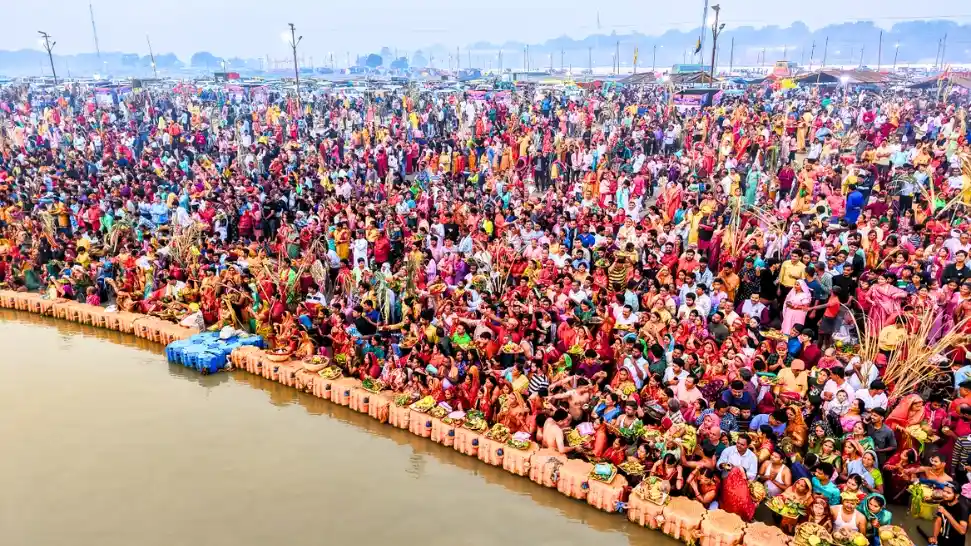Kumbh Mela: A Grand Gathering in Prayagraj

The Kumbh Mela festival is one of the largest religious gatherings in the world. This year, it is taking place in Prayagraj, India, where thousands of Hindu holy men and millions of pilgrims have begun to arrive. The festival, which lasts for 45 days, is expected to draw around 400 million attendees. It is a time for spiritual cleansing and renewal, as devotees flock to the sacred confluence of the Ganges, Yamuna, and the mythical Saraswati rivers. The event is not only a significant religious occasion but also a remarkable spectacle that can be seen from space.
Preparations for the Festival
As the Kumbh Mela approaches, authorities in Prayagraj are working tirelessly to prepare the city for the influx of visitors. The festival officially begins on Monday, and preparations are crucial to ensure a smooth experience for the millions expected to attend. A vast tent city has been established along the riverbanks, covering an area of 4,000 hectares. This city includes 160,000 tents, 150,000 toilets, and 67,000 street lights to accommodate the pilgrims.
However, just hours before the festival’s commencement, many areas still appeared unfinished. Reports indicate that some camps lacked basic amenities like water and electricity. Additionally, thousands of toilet cubicles were either incomplete or unusable due to missing water connections. Vivek Chaturvedi, an administration official, acknowledged the challenges posed by delayed monsoon waters, which limited construction time. Despite these setbacks, he assured that preparations were nearly complete, with over 100,000 personnel, including police and sanitation workers, working around the clock to ensure the event’s success.
The Significance of Kumbh Mela
The Kumbh Mela has deep roots in Hindu mythology. It commemorates a celestial battle between gods and demons over a pitcher of nectar that grants immortality. According to legend, drops of this nectar fell into four locations: Prayagraj, Haridwar, Ujjain, and Nashik. The festival occurs every 12 years in these cities, with Prayagraj hosting the largest gatherings. This year’s festival is particularly special, as the alignment of planets and stars is said to mirror the conditions during the original nectar spill, a phenomenon that occurs once every 144 years.
For many, the highlight of the Kumbh Mela is the ritual bathing in the sacred rivers. Hindus believe that immersing themselves in these waters cleanses them of sins and purifies their souls. The first major bathing day is set for Tuesday, where millions are expected to participate. The presence of Naga sadhus, or ascetics, adds to the festival’s allure. These holy men, often seen naked and smeared with ash, are believed to embody spiritual purity, and their participation is a significant draw for both pilgrims and tourists.
Major Bathing Days and Their Importance
Astrologers determine the auspicious bathing dates based on celestial alignments. This year, six key bathing days have been identified, with the largest expected on January 29, when 50 to 60 million worshippers are anticipated to bathe. The first major bathing day, January 13, marks the beginning of the festival, followed by significant dates like Makar Sankranti on January 14 and Mauni Amavasya on January 29.
The Shahi Snan, or royal bath days, are particularly noteworthy. On these days, the Naga sadhus lead the bathing rituals, drawing massive crowds. The spiritual significance of these days is immense, as devotees believe that bathing during these auspicious times amplifies the cleansing effects of the sacred waters. As the festival unfolds, the atmosphere in Prayagraj transforms into a vibrant tapestry of faith, devotion, and cultural expression.
The Scale of Kumbh Mela
The Kumbh Mela is not just a religious event; it is a logistical marvel. The Indian government has allocated approximately 70 billion rupees (around $812 million) for organizing the festival. Local media reports suggest that the state government expects to generate 250 billion rupees ($2.9 billion) in revenue from the event. The scale of the preparations is staggering, with 30 floating bridges constructed over the river to facilitate movement and 200 water ATMs set up for convenience.
Despite the extensive planning, some pilgrims have expressed concerns about the adequacy of facilities. While the infrastructure is impressive, there are reports of shortages and issues with sanitation. Many pilgrims, especially the sadhus, feel that their needs are overlooked in favor of tourists. As the festival progresses, the balance between accommodating millions and maintaining spiritual sanctity will be a critical focus for organizers.
The Kumbh Mela in Prayagraj is a testament to the enduring power of faith and community. As the festival unfolds, it promises to be a remarkable celebration of spirituality, culture, and human connection.
Observer Voice is the one stop site for National, International news, Sports, Editor’s Choice, Art/culture contents, Quotes and much more. We also cover historical contents. Historical contents includes World History, Indian History, and what happened today. The website also covers Entertainment across the India and World.

